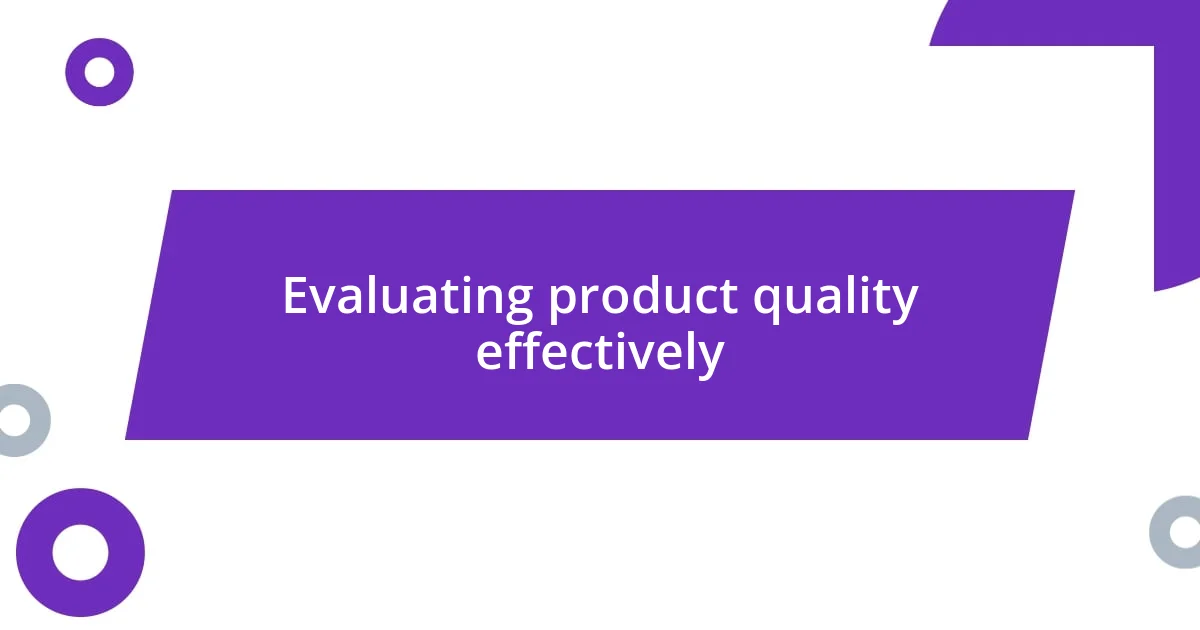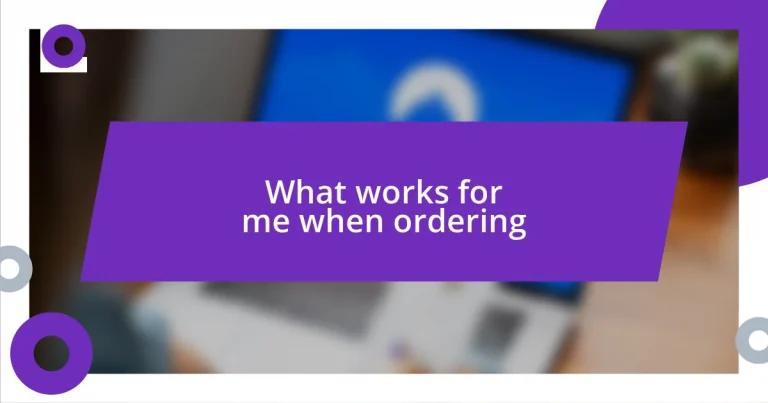Key takeaways:
- Understanding ordering needs is influenced by convenience, quality, mood, and dietary preferences, emphasizing the importance of the overall experience.
- Selecting the right ordering platform involves considering user interface, customer reviews, delivery areas, payment options, and promotional offers to enhance the ordering experience.
- Building long-term vendor relationships relies on open communication, consistency in service, and appreciation, fostering loyalty and positive interactions.

Understanding my ordering needs
When I think about my ordering needs, I realize they’re shaped by a mix of convenience and quality. For instance, I remember a time when I was juggling work and personal commitments. I desperately needed a meal that was both satisfying and quick to arrive. It made me appreciate the importance of options that not only save time but also deliver on flavor.
I’ve also discovered that my choices are influenced by my mood and the occasion. Sometimes, I crave comfort food that reminds me of home, like the mac and cheese my grandmother used to make. It’s fascinating how food can evoke memories and emotions, don’t you think? This connection highlights why understanding my needs goes beyond just the meal itself; it’s about the experience that comes with it.
Another factor I consider is dietary preferences and restrictions. There was a time when I didn’t pay enough attention to what I was ordering, and I ended up feeling sluggish after a heavy meal. Now, I always make a point to check ingredients and nutritional information. I’m curious—does anyone else feel that difference when they choose healthier options? For me, the right order can positively impact my day.

Choosing the right platforms
When it comes to choosing the right platforms for ordering, I’ve found that my experience varies greatly depending on the service I use. I remember once trying a new app that advertised lightning-fast delivery, only to be left waiting for what felt like an eternity. That taught me the value of reliability over mere speed. I now prefer using platforms with a strong reputation for customer service and timely deliveries, because nothing beats that peace of mind when I’m hungry.
Key factors I consider when selecting an ordering platform include:
- User interface: A simple, intuitive design helps me navigate menus quickly.
- Customer reviews: I always check feedback on food quality and delivery timeliness; it gives me confidence in my choice.
- Delivery areas: I ensure the platform covers my location effectively to avoid last-minute surprises.
- Payment options: Flexibility in payment methods is crucial to my ordering experience.
- Promotions and loyalty programs: Discounts or rewards can make a significant difference, especially for frequent orders.
I’ve learned that these aspects can elevate the entire ordering experience, turning a mundane task into something enjoyable and seamless.

Evaluating product quality effectively
Evaluating product quality effectively involves several key steps that help me feel confident about what I’m ordering. One technique I utilize is closely examining product descriptions and images. I recall a time when I overlooked details and ended up with a dish that looked nothing like its digital counterpart. Since then, I’ve learned to look for clear, appealing photos and specific ingredient lists, which greatly enhance my confidence in the overall quality.
Another insightful approach is to emphasize customer reviews, especially regarding food quality. It’s not just about star ratings; I pay attention to detailed comments. I remember ordering from a restaurant with rave reviews but later found the dish lacking in flavor and freshness. This taught me that consistency in feedback matters—often, the honest critiques reveal more than the general consensus. Diving deeper into the context of reviews can truly inform my decisions.
Lastly, I consider the return policies or satisfaction guarantees, especially when ordering from new vendors. Recently, I ordered from a new place that offered a money-back guarantee. When my food arrived cold and unappetizing, I felt reassured knowing I could voice my disappointment without hassle. It’s this layer of security that enhances my overall trust in the product quality I’m receiving.
| Evaluation Criteria | Importance |
|---|---|
| Product Descriptions and Images | Ensure clarity and appeal to set expectations |
| Customer Reviews | Reveal insights into actual product quality |
| Return Policies/Satisfaction Guarantees | Provide security and trust in the ordering process |

Comparing prices and value
When I compare prices, I always think about the concept of value. It’s not just about finding the cheapest option; it’s about what I’m actually getting for my money. For instance, I had an experience where I chose a low-priced meal, only to find it was tiny and lacked flavor. It left me feeling unsatisfied, which made me realize that spending a little more for quality can be worth it in the end.
I also find that promotions play a significant role in my decision-making. Recently, I came across a restaurant offering 20% off my first order. While the price was attractive, I dug further into their reviews and discovered that their food was consistently praised for its quality. That made my choice easier. I often ask myself: Is it better to save a few dollars or invest in a meal that will truly satisfy me? I’ve learned that value often outweighs the initial price.
Moreover, I take note of the hidden costs that can creep in. Sometimes, a platform may boast low delivery fees, but then I encounter extra charges that quickly add up. Just the other night, I ordered from a well-known service and was shocked by the overall bill after delivery and service charges. I think it’s essential to look beyond the upfront price. Have you ever found yourself in a similar situation? It’s those unexpected charges that remind me to scrutinize my orders more carefully in the future.

Reading customer reviews critically
When reading customer reviews, it’s vital for me to keep an open yet critical mind. I recall a time I was swayed by a glowing review about a burger that promised gourmet flavors. However, the actual experience fell flat—like the time I tried it and it tasted more like cardboard than anything else! This taught me that while enthusiasm is appealing, it’s important to look for balanced feedback that includes both positive and negative aspects. Have you ever been caught in a similar trap?
Additionally, I find that reading between the lines of reviews can reveal a lot more than face value. For instance, I once read a review that praised a pizza place, but it also mentioned that the delivery took over an hour. While the pizza was delicious, I realized that timeliness was critical for a satisfying meal. Context matters! I often ask myself: What other factors are hidden in the reviews that could impact my experience? It’s this deeper analysis that often makes or breaks my ordering decisions.
Furthermore, I’m mindful of personal biases that can seep into reviews. I’ve seen some people rate a restaurant poorly simply because their preferred meal wasn’t available. I think about how I might rate a place based on my expectations rather than the overall quality. By being aware of this, I try to focus on tangible details—like the quality of the ingredients or service consistency—rather than getting swept up in an emotional response of others. It’s a reminder to take each review with a grain of salt while seeking the insights that truly resonate with my own expectations.

Managing delivery expectations
When it comes to managing delivery expectations, I’ve learned the hard way that timing can vary significantly. There was that one time I ordered dinner for a small gathering, expecting it to arrive in under 30 minutes. Instead, nearly an hour later, my guests were nibbling on chips, and I was left feeling embarrassed. It made me ask: how can I set realistic expectations without feeling let down? Now, I always check the estimated delivery time and allow for some buffer—it’s all about being prepared.
I also find it crucial to track my order in real-time whenever possible. One night, I made the mistake of ignoring the tracking feature while I waited for my pizza. I was anxious, wondering if it had been forgotten. When I finally checked, I saw it was still being made! This simple tool can alleviate so much stress, helping me feel more in control. Have you ever waited impatiently, only to realize you could have just checked your order status? Communication can make a world of difference.
Moreover, I consider the reliability of the delivery service before placing an order. After a particularly frustrating experience with a local delivery company that consistently missed delivery times, I decided to switch to one with a stronger reputation. I still remember how annoyed I felt when my food arrived cold and late; it colored my whole evening. Now, I trust my gut instincts and check reviews about delivery experiences first. It’s a reminder that a great meal can quickly lose its charm if you don’t manage those delivery expectations right from the start.

Building long-term vendor relationships
When it comes to building long-term vendor relationships, I always prioritize open communication. I remember a time when I had a minor issue with an order and decided to reach out to the vendor. Instead of just voicing my frustration, I framed my message as a chance for improvement. Their willingness to listen and address my concerns not only resolved the issue but also solidified my loyalty to them. Have you ever experienced a vendor who turned a frustrating situation into a positive one?
Another key factor is consistency. I’ve noticed that vendors who consistently deliver quality service, whether it’s prompt responses or reliable product quality, become my go-to choices. There’s something comforting about knowing I can count on them. In fact, I often find myself returning to a favorite local bakery not just for their delicious treats, but for the friendly greetings and consistent excellence I experience each time. Doesn’t that kind of reliability make you want to recommend them to others?
Lastly, I believe in the power of showing appreciation. I once took the time to leave a glowing review for a small business that went above and beyond. To my surprise, the owner reached out to thank me personally, which deepened my connection with them. It’s a gentle reminder that acknowledging good service can foster a positive cycle, encouraging vendors to keep striving for excellence. Have you ever felt the real impact of a simple thank you? It’s these small gestures that can transform a transactional relationship into a lasting partnership.












